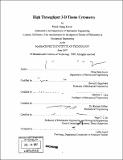High throughput 3-D tissue cytometry
Author(s)
Kwon, Hyuk-Sang, 1971-
DownloadFull printable version (13.46Mb)
Alternative title
High throughput three-dimensional tissue cytometry
Other Contributors
Massachusetts Institute of Technology. Dept. of Mechanical Engineering.
Advisor
Peter T.C. So.
Terms of use
Metadata
Show full item recordAbstract
This thesis presents the ongoing technological development of high throughput 3-D tissue cytometry.and its applications in biomedicine. 3-D tissue cytometry has been developed in our laboratory based on two-photon microscopy (TPM) that is capable of in situ 3-D imaging of tissue up to a volume of several mm3 with subcellular resolution. This high throughput tissue cytometry achieves an imaging rate of 2 mm3/hour. I optimize the performance of this instrument by developing two new techniques. First, the image signal-to-noise-ratio and the microscope penetration depth can be improved by reducing tissue scattering. Optical clearing agents can significantly lower tissue scattering by index matching of different tissue constituents. While the application of tissue clearing agent has been extensively studied in fresh tissues, its application has not been extensively studied in paraffin fixed and frozen tissues. Frozen tissues are particularly important as tissue sections can be retained for biochemical and genetic analysis after fluorescence imaging. We investigate the effects of optical clearing agents in sub-zero temperature in terms of TPM image contrast and penetration depth. Second, tissue cytometry are often used in the detection of rare cells. (cont.) In this case, if the region containing these rare cells can be identified by low magnification imaging first, there is no need to image the whole tissue specimen. I modified the two-photon tissue cytometer to incorporate a low magnification, wide field, one-photon imaging subsystem. Wide field surface imaging allows us to locate regions of interest and to perform high resolution 3-D imaging only at these locations using a micron precision x-y specimen positioner. 3-D tissue cytometry is applied in two biomedical applications. In the first project, in collaboration with Prof. Bevin Engelward, we study the frequency, the distribution and the clonal expansion rate of cells that undergo recombination during cell division using genetically engineered mice. The Fluorescent Yellow Direct Repeat (FYDR) mice developed by the Engelward group have cells that express yellow fluorescent proteins if recombination occurs during cell division. In the second project, in collaboration with Dr. Richard Gilbert, we investigate the muscle architecture of whole mouse tongues. Dr. Gilbert's group has shown that force generation and deformation of the tongue can be characterized by "fiber tracks" observed in tongues using high field MRI. However, the morphological origin of these tracks has not been fully qualified on the cellular level and we seek to correlate these tracks with structures observed using 3-D tissue cytometry.
Description
Thesis (Ph. D.)--Massachusetts Institute of Technology, Dept. of Mechanical Engineering, 2007. Includes bibliographical references (leaves 95-102).
Date issued
2007Department
Massachusetts Institute of Technology. Department of Mechanical EngineeringPublisher
Massachusetts Institute of Technology
Keywords
Mechanical Engineering.